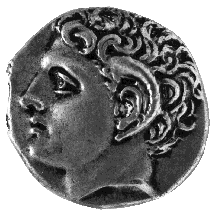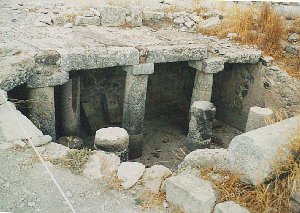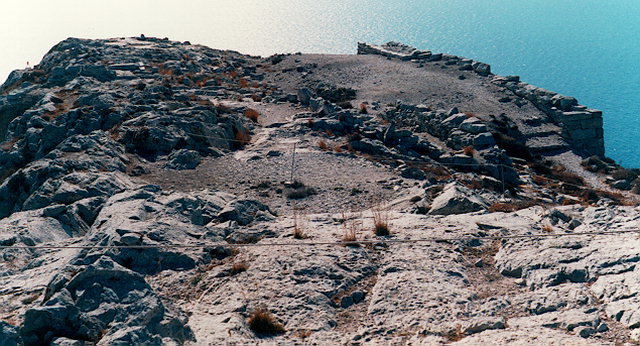Summary
Some
twenty rock inscriptions made in what was then the brand new
Greek alphabet have been found on the Greek island of Santorini
(ancient Thera), indicating the presence of a large and exuberantly
vocal community of homoerotically-inclined young men, who were
participants in the worship of Apollo Karneios (Horned Apollo)
some 2700 years ago.

[Coin showing the head of Apollo Karneios, with a ram's horn wrapping around his ear]
Another ancient Greek inscription from Sicily reveals a sexually symbolic intimacy shared by two women.
Scholarly consensus indicates that the Greeks formed the first true alphabet around 750 BC, most likely on the Greek island of Euboia. This original version of the Greek alphabet (known as the "red" alphabet by scholars; later versions are classified as blue or green) was based on Phoenician, an ancient Semitic writing system (or signary). Greek is considered the first true alphabet because it made the huge leap of being the first writing system to record all vowels fully, so that any person who learned the letter sounds could reasonably approximate the Greek language without being a native speaker. Until the formation of the "red" Greek alphabet, all writing systems merely recorded either entire syllables (like the 700 Egyptian hieroglyphs or 50,000 Chinese logograms) or only consonants (like all Semitic signaries). With the introduction of an alphabet that had vowels, the ability to read and write forever left the exclusive domain of the well-educated elite of ancient societies and began to spread amongst middle- and lower-classes of Greek peoples - a primary and essential step towards the later concept of Greek democracy.
Very few early Greek inscriptions have been discovered (perhaps 50 dating prior to 650 BC). However, I was very pleasantly surprised to find that some 20 of those 50 inscriptions were made by Greek epheboi (young men aged 14-18) who celebrated their homosexual antics, related to the worship of Horned Apollo; these inscriptions have been dated to 700-650 BC. One other inscription in ancient Greek (this one dating to 700 BC from Greek colonists in Sicily) records the intimate and sexually symbolic gifts which one woman gave to another.
This last inscription was found in the 1960s on a salt cellar in Selinus, Sicily. (I transliterate all Greek inscriptions quoted in this article into the Roman alphabet for ease in reading them.) The inscription reads Woinantha m'edoke M[ur]tikhai kai tainian - or, "Wine-Flower" gave me [i.e. the salt cellar] and a breast-binding strap to "Myrtleberry". Significantly, several ancient Greek hetairai shared these two names; hetairai were professional Greek courtesans who were well-educated and allowed to participate in and influence Greek politics (the only women in Greek society allowed to have a public life); many of the hetairai are known or believed to have been (sexual) Lesbians. The salt cellar in question is a small, slightly oblong cup and appears to be a representation of a vagina. That Wine-Flower would give both a vaginally-shaped cup and a proto-bra to Myrtleberry suggests sexual intimacy between the two women. Both were probably courtesans as well since both women are apparently literate in the brand new Greek alphabet and both names were commonly used by hetairai. In addition, Aristophanes indicates in his Lysistrata that myrtleberry itself was a Greek symbol of female genitalia.
While this inscription seems rather covert and private, the sexual exuberance of the inscriptions on Santorini (or ancient Thera) is markedly in contrast. These homoerotic inscriptions are found near the ruins of a sanctuary to Horned Apollo (a god worshipped by Spartans who settled on Santorini after most of it exploded in a massive volcanic eruption around 1520 BC - almost certainly the basis for the Greek myth of the destruction of Atlantis, as well as the Hebrew myth of the "plagues of Moses" that fell upon Egypt at that time, and which may have been the result of volcanic ash and debris littering the Egyptian coastline).

[The sanctuary to Apollo Karneios on Santorini]
The worship of Horned Apollo included ecstatic naked dancing and feats of acrobatics (including an early form of two-man ritual volleyball played with a bright purple ball!) followed by sex performed by young men. First among the sanctuaries and temples of the island was that of Apollo Karneios, and in the middle of the month Karneios (August-September) the Karneia took place - the solemn and important festival introduced from Sparta. At the height of the festivities and when the moon was full, the Gymnopaediae (which means "naked boy ritual") were held. On a specially dedicated square, close by the cliff edge, and watched by the citizens, naked boys danced and sang paeans to Apollo and apparently had sex (some of whom were moved to express their feelings in the brand new Greek alphabet which are still visible in the nearby stones).

[The boulders where these inscriptions
are found on Santorini]
The inscriptions run from the subtle to the blatant, from the sublime to the crass, most written in complex hexametric poetry. One reads, "Barbax dances beautifully and he's given me pleasure" and is signed by a man named [--]atoklas (the first part of his name is missing). A series of inscriptions on another boulder begins with Tharumakhas agathos. Agathos is a difficult word to translate into English. At its most basic level, it means handsome or beautiful. But in the classical Greek psyche, agathos (the beautiful) and kalos (the good) are inextricably entwined: the good is always beautiful and the beautiful is always good (or goodness is indelibly written upon the body in the form of beauty). So I translate this inscription as "Tharmukhas is handsome" but with the understanding that Tharmukhas' moral purity (i.e. proper worship of the gods and obedience to social law and custom) is also implied. Following that inscription is "Luqudidas is also handsome" (again, agathos). Then a third inscription in the series one-ups the first two inscriptions with "But Eumelos is the best at dancing". Lastly, a man named Simias outdoes the whole series with "Krimon, number one at 'dirty-dancing', has melted Simias". The Greek word qonialoi that I have translated as dirty-dancing, is more literally the satyr-like dance of men with full erections.
However this is not the last we hear of the randy young Krimon! On a nearby rock we find the inscription, "By the Delphian god [i.e. Apollo], right here Krimon got fucked [oiphe], by the son of Bathukles, brother of..." (the rest broken off). And again on another boulder: "Here Krimon fucked Amotion". On this same rock is a list of other ephebes that Krimon had sex with: Isokarthus, Pasiowhos, Euaiswros, Kresilas, and the incomplete name [---]deleos. Below this list is the incomplete inscription "Euponos fucked...."
Another boulder bears the lengthy inscription, "Pheidipidas fucked Timagoras. Empheres and I got fucked too." The "I" of this sentence is probably Enpulos who signed below this inscription with "Enpulos did this". Above his name, another young man has rather unkindly scratched the word pornos - whore! On the same rock another young man recorded, "Enpedokles did this. And he danced for Apollo."
Ritual and non-ritual homosexuality probably continued as an integral part of this location for many centuries. Long after these inscriptions were made, Apollo Karneios continued to be worshipped in this location by naked, dancing, volleyball-playing ephebes. In addition, a nearby cave complex bears inscriptions indicating it was used as a place of worship for the bisexual god Hermes and the bisexual hero Herakles (Hercules). Some 400 years later (ca. 300 BC), this rocky area became the location for a Greek gymnasium - a place for ephebes to bathe and practice all sporting events in the nude.
The Greek inscriptions that are older than these homoerotic ones of Santorini are almost all simple names or dedications to gods. Then suddenly comes this explosive moment in Western history; these lengthy inscriptions reveal a radical convergence of ritual worship, desire, exuberant homosexuality, poetry, ecstatic dance, sports, aesthetics, and humor - all witnessing the seeds of democracy by being recorded in the earliest moments of the world's first alphabet.
This fascinating peek into early Greek ritual and sexuality shows a vibrant and unashamed community of homoerotically-inclined young men, somewhat at odds with the later "classical" Athenian society of Socrates and Plato, which did allow for intergenerational homoeroticism, but which far more emphasized and valued a "platonic" love over a more fleshly one, a split between the spirit and the flesh which the western world is still trying to mend some 2400 years later.
For more information on the erotic inscriptions of Santorini, see Barry Powell's book, Homer and the Origin of the Greek Alphabet.
_____
Caption for graphics (coming soon):
A boulder from Santorini bears the following homoerotic ritual inscriptions carved by young men . The earliest Greek inscriptions were written in either direction, right to left or left to right, as shown here.
A: (right to left) Pheidipidas oiphe Timagoras. Kai Enpheres kai ego oiph[omes] - "Pheidipidas fucked Timagoras. And Enpheres and I got fucked."
B: (right to left) Enpulos tade - "Enpulos did this."
C: (left to right) Pornos - "Whore."
D: (right to left) Enpedokles eneqopteto tade. Qorketo ma ton Apolo - "Enpedokles did this. And he danced for Apollo."